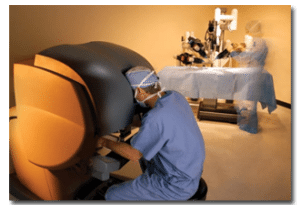da Vinci Hysterectomy
for Benign Conditions
About da Vinci Robotic Surgery
da Vinci Hysterectomy for Benign Conditions
Many benign (non-cancerous) conditions can affect a woman’s reproductive system to the extent where a hysterectomy is advised. Doctors often recommend hysterectomy when medication or lifestyle changes do not provide a cure or ease your symptoms.
The most common surgery to treat gynecologic conditions such as heavy bleeding, fibroids, endometriosis and pelvic prolapse is a hysterectomy – the removal of the uterus. In fact, one in three women in the U.S. will have a hysterectomy before she turns 60.1While this figure is lower in many other parts of the world, hysterectomy is still a common procedure worldwide.
Nowadays, many women avoid the large incision and 4-6 week2 recovery that come with traditional open hysterectomy by choosing minimally invasive surgery. Standard laparoscopic surgery is minimally invasive, but the long-handled, rigid instruments can be challenging for surgeons in more delicate or complex operations.
da Vinci Hysterectomy
Fortunately, there is a minimally invasive option for treating gynecologic conditions designed to overcome the limitations of traditional surgical approaches – da Vinci Surgery.
If your doctor recommends a hysterectomy to treat your condition, you may be a candidate for da Vinci Surgery. Using state-of-the-art technology, a da Vinci® Hysterectomy requires only a few tiny incisions, so you can get back to your life faster.
The da Vinci System enables your doctor to perform a minimally invasive hysterectomy even for complex conditions — with enhanced vision, precision, dexterity and control. da Vinci offers women many potential benefits over traditional surgery, including:
- Less pain
- Fewer complications
- Less blood loss
- Shorter hospital stay
- Low risk of wound infection
- Quicker recovery and return to normal activities
The da Vinci System is a state-of-the-art surgical platform with 3D, high-definition vision and miniaturized, wristed surgical instruments designed to help doctors take surgery beyond the limits of the human hand. By helping doctors to overcome the challenges of traditional open and laparoscopic surgery, da Vinci is changing the experience of surgery for women around the world.
If you have been told you need a hysterectomy, it’s time to ask your doctor about da Vinci Surgery.
- “Hysterectomy”. Medline Plus; A Service of the U.S. National Library of Medicine – National Institutes of Health. Available from: http://www.nlm.nih.gov/medlineplus/hysterectomy.html
- National Institutes of Health., A Service of the U.S. National Library of Medicine. “Hysterectomy”. Available from: http://www.nlm.nih.gov/medlineplus/ency/article/002915.htm
- Ko EM, Muto MG, Berkowitz RS, Feltmate CM.Robotic versus open radical hysterectomy: a comparative study at a single institution. Gynecol Oncol. 2008 Dec;111(3):425-30. Epub 2008 Oct 16.
- Piquion-Joseph JM, Navar A, Ghazaryan A, Papanna R, Klimek W, Laroia R. Robot-assisted gynecological surgery in a community setting. Journal of Robotic Surgery, 2009:1-4.
- DeNardis SA, Holloway RW, Bigsby GE, Pikaart DP, Ahmad S, and Finkler NJ. Robotically assisted laparoscopic hysterectomy versus total abdominal hysterectomy and lymphadenectomy for endometrial cancer. Gynecologic Oncology 2008;111:412-417.
- Payne, T. N. and F. R. Dauterive. A comparison of total laparoscopic hysterectomy to robotically assisted hysterectomy: surgical outcomes in a community practice. J Minim Invasive Gynecol, 2008;15(3): 286-291.
- Boggess JF, Gehrig PA, Cantrell L, Shafer A, Ridgway M, Skinner EN, Fowler WC. A comparative study of 3 surgical methods for hysterectomy with staging for endometrial cancer: robotic assistance, laparoscopy, laparotomy. Am J Obstet Gynecol. 2008 Oct;199(4):360.e1-9.
- Bell MC, Torgerson J, Seshadri-Kreaden U, Suttle AW, Hunt S. Comparison of outcomes and cost for endometrial cancer staging via traditional laparotomy, standard laparoscopy and robotic techniques. Gynecol Oncol. 2008 Dec;111(3):407-11. Epub 2008 Oct 1.
Understanding Outcomes
As with any surgery, these benefits cannot be guaranteed since surgery is specific to each patient, condition and procedure. It is important to talk to your doctor about all treatment options, including the risks and benefits. This information can help you to make the best decision for your situation.
While clinical studies support the effectiveness of the da Vinci Surgical System when used in minimally invasive surgery, individual results may vary. There are no guarantees of outcome. All surgeries involve the risk of major complications. Before you decide on surgery, discuss treatment options with your doctor. Understanding the risks of each treatment can help you make the best decision for your individual situation. Surgery with the da Vinci Surgical System may not be appropriate for every individual; it may not be applicable to your condition.
Always ask your doctor about all treatment options, as well as their risks and benefits. Only your doctor can determine whether da Vinci Surgery is appropriate for your situation. The clinical information and opinions, including any inaccuracies expressed in this material by patients or doctors about da Vinci Surgery, are not necessarily those of Suburban Gynecology. and should not be considered as substitute for medical advice provided by your doctor.
For more information, please visit www.davincisurgery.com
Robotic Surgery
Using the da Vinci Robotic Surgery system, surgeons can operate with GREATER PRECISION & control with a high definition 3D VISION & a magnified view.

To learn more about da Vinci Robotic Surgery please take a moment to view our educational library.


